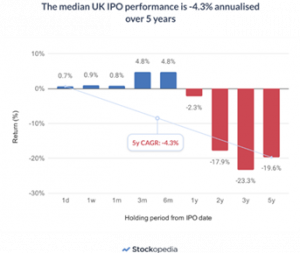New analysis by online investment research platform Stockopedia reveals that the odds are stacked against private investors when it comes to investing in, and profiting from, new company IPOs.
2021 has proven to be a remarkable year for IPOs despite economic uncertainty during the COVID-19 pandemic. There were more flotations in the first half of the year than there were throughout 2020, including recent high-profile listings from Deliveroo, Dr Martens and Moonpig.
But are individual investors able to benefit from this IPO boom?
By analysing thousands of data points for 258 UK-listed IPOs over five years (January 2016 – May 2021), Stockopedia’s new IPO Survival Guide provides strong evidence of structural bias in the current system that puts private investors at a disadvantage.
This is because deal underwriters market large pre-IPO purchases with institutional clients before a company is floated on the London Stock Exchange, making it impossible for private investors to buy shares at the all-important issue price.
Stockopedia has found 89% of IPOs open higher than their issue price (211 out of 258 IPOs studied). Furthermore, the average price “pop” from the issue price to the opening price on the first day of trading is nearly 10%.
The uneven performance distribution of UK IPOs
Stockopedia’s study also highlights the uneven performance distribution of IPOs and where private investors have the most to gain (and to lose).
On a median basis, the 3-to-6-month timeframe appears to be the sweet spot for holding IPOs in the short term. But when you adjust for extreme values, the central tendency is for IPOs to perform extremely poorly over the long term.
Indeed, the researchers found a negative median compound annual growth rate (CAGR) of -4.3% for the 258 UK IPOs studied, across five years.

Although the odds of picking big IPO winners are low for private investors, Healthcare (+153%) and Technology (+110%) IPOs have offered the most promising returns over the past five years, accelerated by demand during the COVID-19 pandemic.
Interestingly, small caps that are often under-researched and underappreciated by the market outperform mid and large caps on almost all metrics assessed.
Over the past five years, the average performance of small-cap IPOs was 85%. This is compared to large caps with a negative performance of -20%, one-to-two years after the IPO.
The research also found that company quality and market valuation have a very significant bearing on future price performance – meaning that investors need to tread carefully when it comes to choosing which IPOs to invest in.
A joint survey with interactive investor of 1,200 private investors found that just 16% were out to make a quick profit from an IPO, with a third preferring to buy IPOs for their long-term growth potential. A further 23% said they would invest for the medium term, before selling their shares.
This could mean many DIY investors are putting their capital at risk given the research finding that the longer you hold an IPO, the less chance you have of outperformance.





